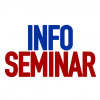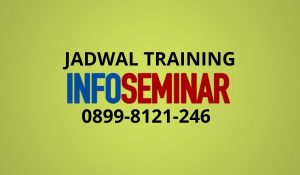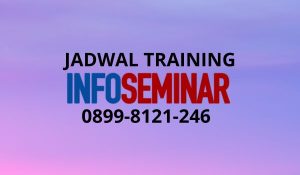Information Technology Quality Assurance (JAKARTA)
Jakarta, 3 November 2015 – 5 November 2015
Including : Souvenir, Flash disk, materi hand-out dan CD modul, 2x coffee break, makan siang dan sertifikat
Description
This three-day foundation course is designed for learning and understanding IT quality concepts. It provides an excellent overview of the entire IT quality professional area.
It further provides a macro introduction of the quality assurance area by introducing and reviewing the principles expounded by leading quality experts.
This training also addresses the important aspects to consider for those organizations that desire to properly organize their quality initiative for improved productivity and organizational integrity. It includes certain case study analyses to reaffirm topic areas covered.
The training introduced the important quality principles, concepts, responsibilities and vocabulary, will conduct a brief quality management self-assessment, will learn how to implement an IT quality program and will learn how to build a short term action program for your IT organization.
This training also addresses the important aspects to consider for those organizations that desire to properly organize their quality initiative for improved productivity and organizational integrity.
Objectives
Participants will learn to implement detailed Information Technology Quality Assurance programs, policies and procedures, including:
- Learning the fundamentals of software quality principles, concepts, responsibilities, and vocabulary.
- Each participant will conduct a brief quality management self-assessment.
- Provide a step-by-step process to implement an IT quality program.
- Learn where your organization is and where it wants to be in a quality function.
- Learn how to make it happen and where to start on the quality journey.
- Help you build a short term action program for your IT organization by completing a quality action plan.
- Where and how to apply Information Technology QA concepts to achieve maximum quality benefit
- Quality factors that must be considered on every IT project
- Project and quality metrics
- Detailed analysis of the Software Engineering Institute’s concepts for IT Quality Assurance and how to apply
Target Audience
- Quality Assurance Managers/Supervisors/Analysts
- IT Managers
- Project Leaders
- IT Service Users
- QA Leaders
Duration : 3 Days
Course Contents and Descriptions
I.General Quality Management
- Quality principles
- Benefits of software quality
Describe the benefits that software quality engineering can have at the organizational level. - Organizational and process benchmarking
Use benchmarking at the organizational, process, and project levels to identify and implement best practices.
- Benefits of software quality
- Ethical and Legal Compliance
- ASQ Code of Ethics
Determine appropriate behavior in situations requiring ethical decisions, including identifying conflicts of interest, recognizing and resolving ethical issues, etc. - Legal and regulatory issues
Define and describe the impact that issues such as copyright, intellectual property rights, product liability, data privacy, the Sarbanes-Oxley Act, etc., can have on software development.
- ASQ Code of Ethics
- Standards and models
Define and describe the following standards and assessment models: ISO 9000 standards, IEEE software standards, and the SEI Capability Maturity Model Integrated (CMMI).
- Leadership skills
- Organizational leadership
Use leadership tools and techniques, such as organizational change management, knowledge-transfer, motivation, mentoring and coaching, recognition, etc. - Facilitation skills
Use various approaches to manage and resolve conflict. Use negotiation techniques and identify possible outcomes. Use meeting management tools to maximize performance. - Communication skills
Use various communication elements (e.g., interviewing and listening skills) in oral, written, and presentation formats. Use various techniques for working in multi-cultural environments, and identify and describe the impact that culture and communications can have on quality.
- Organizational leadership
- Team Skills
- Team management
Use various team management skills, including assigning roles and responsibilities, identifying the classic stages of team development (forming, storming, norming, performing, adjourning), monitoring and responding to group dynamics, and working with diverse groups and in distributed work environments. - Team tools
Use decision-making and creativity tools, such as brainstorming, nominal group technique (NGT), multi-voting, etc.
- Team management
- Software Quality Management
- Quality Management System
- Quality goals and objectives
Design quality goals and objectives for programs, projects, and products that are consistent with business objectives. Develop and use documents and processes necessary to support software quality management systems. - Customers and other stakeholders
Describe and distinguish between various stakeholder groups, and analyze the effect their requirements can have on software projects and products. - Planning
Design program plans that will support software quality goals and objectives. - Outsourcing
Determine the impact that acquisitions, multi-supplier partnerships, outsourced services, and other external drivers can have on organizational goals and objectives, and design appropriate criteria for evaluating suppliers and subcontractors.
- Quality goals and objectives
- Methodologies
- Cost of quality (COQ)
Analyze COQ categories (prevention, appraisal, internal failure, external failure) and their impact on products and processes. - Process improvement models
Define and describe elements of lean tools and the six sigma methodology, and use the plan-do-check-act (PDCA) model for process improvement. - Corrective action procedures
Evaluate corrective action procedures related to software defects, process nonconformances, and other quality system deficiencies. - Defect prevention
Design and use defect prevention processes such as technical reviews, software tools and technology, special training, etc.
- Cost of quality (COQ)
- Audits
- Audit types
Define and distinguish between various audit types, including process, compliance, supplier, system, etc. - Audit roles and responsibilities
Identify roles and responsibilities for audit participants: client, lead auditor, audit team members and auditee. - Audit process
Define and describe the steps in conducting an audit, developing and delivering an audit report, and determining appropriate follow-up activities.
- Audit types
- Quality Management System
- Systems and Software Engineering Processes
- Lifecycles and process models
Evaluate various software development lifecycles (iterative, waterfall, etc.) and process models (V-model, Feature Driven Development, Test Driven Development, etc.) and identify their benefits and when they should be used. - Systems architecture
Identify and describe various architectures, including embedded systems, client-server, n-tier, web, wireless, messaging, collaboration platforms, etc., and analyze their impact on quality. - Requirements engineering
- Requirements types
Define and describe various types of requirements, including feature, function, system, quality, security, safety, regulatory, etc. - Requirements elicitation
Describe and use various elicitation methods, including customer needs analysis, use cases, human factors studies, usability prototypes, joint application development (JAD), storyboards, etc. - Requirements analysis
Identify and use tools such as data flow diagrams (DFDs), entity relationship diagrams (ERDs), etc., to analyze requirements.
- Requirements types
- Requirements management
- Participants
Identify various participants who have a role in requirements planning, including customers, developers, testers, the quality function, management, etc. (Understand) - Requirements evaluation
Assess the completeness, consistency, correctness and testability of requirements, and determine their priority. - Requirements change management
Assess the impact that changes to requirements will have on software development processes for all types of lifecycle models. - Bidirectional traceability
Use various tools and techniques to ensure bidirectional traceability from requirements elicitation and analysis through design and testing.
- Participants
- Software analysis, design, and development
- Design methods
Identify the steps used in software design and their functions, and define and distinguish between software design methods such as object-oriented analysis and design (OOAD), structured analysis and design (SAD), and patterns. - Quality attributes and design
Analyze the impact that quality-related elements (safety, security, reliability, usability, reusability, maintainability, etc.) can have on software design. - Software reuse
Define and distinguish between software reuse, reengineering, and reverse engineering, and describe the impact these practices can have on software quality. - Software development tools
Select the appropriate development tools to use for modeling, code analysis, etc., and analyze the impact they can have on requirements management and documentation. (Analyze) - Software development methods
Define and describe principles such as pair programming, extreme programming, cleanroom, formal methods, etc., and their impact on software quality.
- Design methods
- Lifecycles and process models
- Maintenance management
- Maintenance types
Describe the characteristics of corrective, adaptive, perfective, and preventive maintenance types. - Maintenance strategy
Describe various factors affecting the strategy for software maintenance, including service-level agreements (SLAs), short- and long-term costs, maintenance releases, product discontinuance, etc., and their impact on software quality.
- Maintenance types
- Project Management
- Planning, scheduling, and deployment
- Project planning
Use forecasts, resources, schedules, task and cost estimates, etc., to develop project plans. - Project scheduling
Use PERT charts, critical path method (CPM), work breakdown structure (WBS), Scrum, burn-down charts, and other tools to schedule and monitor projects. - Project deployment
Use various tools, including milestones, objectives achieved, task duration, etc., to set goals and deploy the project.
- Project planning
- Tracking and controlling
- Phase transition control
Use phase transition control tools and techniques such as entry/exit criteria, quality gates, Gantt charts, integrated master schedules, etc. - Tracking methods
Calculate project-related costs, including earned value, deliverables, productivity, etc., and track the results against project baselines. - Project reviews
Use various types of project reviews such as phase-end, management, and retrospectives or post-project reviews to assess project performance and status, to review issues and risks, and to discover and capture lessons learned from the project. - Program reviews
Define and describe various methods for reviewing and assessing programs in terms of their performance, technical accomplishments, resource utilization, etc.
- Phase transition control
- Risk management
- Risk management methods
Use risk management techniques (assess, prevent, mitigate, transfer) to evaluate project risks. - Software security risks
Evaluate risks specific to software security, including deliberate attacks (hacking, sabotage, etc.), inherent defects that allow unauthorized access to data, and other security breaches, and determine appropriate responses to minimize their impact. - Safety and hazard analysis
Evaluate safety risks and hazards related to software development and implementation and determine appropriate steps to minimize their impact.
- Risk management methods
- Planning, scheduling, and deployment
- Software Metrics and Analysis
- Metrics and measurement theory
- Terminology
Define and describe metrics and measurement terms including reliability, internal and external validity, explicit and derived measures, etc. - Basic measurement theory and statistics
Define the central limit theorem, and describe and use mean, median, mode, standard deviation, variance, and range. Apply appropriate measurement scales (nominal, ordinal, ratio, interval) in various situations. - Psychology of metrics
Describe how metrics and measuring affect the people whose work is being measured and how people affect the ways in which metrics are used and data are gathered.
- Terminology
- Process and product measurement
- Software metrics
Use metrics to assess various software attributes such as size, complexity, number of defects, the amount of test coverage needed, requirements volatility, and overall system performance. - Process metrics
Measure the effectiveness and efficiency of software using functional verification tests (FVT), cost, yield, customer impact, defect detection, defect containment, total defect containment effectiveness (TDCE), defect removal efficiency (DRE), process capability and efficiency, etc. - Metrics reporting tools
Use various metric representation tools, including dashboards, stoplight charts, etc., to report results efficiently.
- Software metrics
- Analytical techniques
- Sampling
Define and distinguish between sampling methods (e.g., random, stratified, cluster) as used in auditing, testing, product acceptance, etc. - Data collection and integrity
Describe the importance of data integrity from planning through collection and analysis, and apply various techniques to ensure its quality, accuracy, completeness, and timeliness. - Quality analysis tools
Describe and use classic quality tools (flowcharts, Pareto charts, cause and effect diagrams, control charts, histograms, etc.) and problem-solving tools (affinity and tree diagrams, matrix and activity network diagrams, root cause analysis, etc.) in a variety of situations.
- Sampling
- Metrics and measurement theory
- Software Verification and Validation
- Theory
- V&V methods
Select and use V&V methods, including static analysis, structural analysis, mathematical proof, simulation, etc., and analyze which tasks should be iterated as a result of modifications. - Software product evaluation
Use various evaluation methods on documentation, source code, test results, etc., to determine whether user needs and project objectives have been satisfied.
- V&V methods
- Test planning and design
- Test strategies
Select and analyze test strategies (test-driven design, good-enough, risk-based, time-box, top-down, bottom-up, black-box, white-box, simulation, automation, etc.) for various situations. - Test plans
Develop and evaluate test plans and procedures, including system, acceptance, validation, etc., to determine whether project objectives are being met. - Test designs
Select and evaluate various test designs, including fault insertion, fault-error handling, equivalence class partitioning, boundary value, etc. - Software tests
Identify and use various tests, including unit, functional, performance, integration, regression, usability, acceptance, certification, environmental load, stress, worst-case, perfective, exploratory, system, etc. - Tests of supplier components and products
Determine appropriate levels of testing for integrating third-party components and products. - Test coverage specifications
Evaluate the adequacy of specifications such as functions, states, data and time domains, interfaces, security, and configurations that include internationalization and platform variances. - Code coverage techniques
Identify and use techniques such as branch-to-branch, condition, domain, McCabe’s cyclomatic complexity, boundary, etc. - Test environments
Select and use simulations, test libraries, drivers, stubs, harnesses, etc., and identify parameters to establish a controlled test environment in various situations. - Test tools
Identify and use utilities, diagnostics, and test management tools.
- Test strategies
- Reviews and inspections
Identify and use desk-checks, peer reviews, walk-throughs, Fagan and Gilb inspections, etc. - Test execution documentation
Review and evaluate documents such as defect reporting and tracking records, test completion metrics, trouble reports, input/output specifications, etc. - Customer deliverables
Assess the completeness of customer deliverables, including packaged and hosted or downloadable products, license keys and user documentation, marketing and training materials, etc.
- Theory
- Software Configuration Management
- Configuration infrastructure
- Configuration management team
Describe the roles and responsibilities of a configuration management group.
[NOTE: The roles and responsibilities of the configuration control board (CCB) are covered in area VII.C.2.] - Configuration management tools
Describe these tools as they are used for managing libraries, build systems, defect tracking systems, etc. - Library processes
Describe dynamic, static, and controlled processes used in library systems and related procedures, such as check-in/check-out, merge changes, etc.
- Configuration management team
- Configuration identification
- Configuration items
Describe configuration items (documentation, software code, equipment, etc.), identification methods (naming conventions, versioning schemes, etc.), and when baselines are created and used. - Software builds
Describe the relationship between software builds and configuration management functions, and describe methods for controlling builds (automation, new versions, etc.).
- Configuration items
- Configuration control and status accounting
- Item, baseline, and version control
Describe processes for documentation control, tracking item changes, version control, etc., that are used to manage various configurations, and describe processes used to manage configuration item dependencies in software builds and versioning. - Configuration control board (CCB)
Describe the roles and responsibilities of the CCB and its members and the procedures they use.
[NOTE: The roles and responsibilities of the configuration management team are covered in area VII.A.1.] - Concurrent development
Describe the use of configuration management control principles in concurrent development processes. - Status accounting
Discuss various processes for establishing, maintaining, and reporting the status of configuration items.
- Item, baseline, and version control
- Configuration audits
Define and distinguish between functional and physical configuration audits and how they are used in relation to product specifications. - Product release and distribution
- Product release
Review product release processes (planning, scheduling, defining hardware and software dependencies, etc.) and assess their effectiveness. - Archival processes
Review the source and release archival processes (backup planning and scheduling, data retrieval, archival of build environments, retention of historical records, offsite storage, etc.) and assess their effectiveness.
- Product release
- Configuration infrastructure
Case Studies Exercises
During the course, several case studies/exercises are introduced. Attendees have an opportunity to apply their expertise, in the context of the course material, to typical software quality assurance issues.
Trainer :
Dr. Ir. Fauzi Hasan, MM, MBA
Dr. Fauzi Hasan Pada saat ini adalah President American Academy untuk Chapter Indonesia yang melingkupi American Academy of Project Management dan American Academy of Finance Management yang berpusasat di Colorado Spring, Colorado USA.
Pengalaman Dr. Fauzi Hasan diperkaya dengan keterlibatannya pada beberapa proyek terkait Business Process Modeling dan Improvement yang selaras dengan standard dan metodologi CMMI (Capability Maturity Model and Integration), dimana dalam akhir dekade ini banyak membantu organisasi Pemerintah dan Bank dalam membangun dan mengimplementasi Crisis Management Strategy seperti pembuatan BCP (Business Continuity Plan) dan DRP (Disaster Recovery Plan).
Dr. Fauzi Hasan telah memberikan kontribusi langsung untuk penyelesaian dan keberhasilan penerapan Frameworks dan Best Practices seperti: ITIL, COBIT, PMBOK, Prince2, TOGAF, ISO 20000, ISO 27000, ISO 38500, COSO dan yang lain diberbagai bidang industri. Sebagai seorang profesioal yang kompeten di bidang teknologi informasi, manajemen proyek dan proses bisnis ini dibuktikan dengan dimilikinya sejumlah sertifikat Internasional terkait tata kelola teknologi informasi dan industri (IT and Industrial Goverannce).
Dr. Fauzi Hasan dalam karirnya sebagai executive telah bekerja di beberapa perusahaan lokal maupun internasional seperti: Philips Netherlands, Sony , Warner Lambert, Singapore Technology Logistics, Hewlett-Packard, EMTEK Group, Intergraph, Jatis eCom-Sumitomo Group, dan ERESHA Group.
Investasi : Rp 5.000.000,- termasuk ( Souvenir, Flash disk, materi hand-out dan CD modul, 2x coffee break, makan siang dan sertifikat )
Tempat : Hotel Harris Tebet, Jl. Dr. Sahardjo No. 191 – Jakarta Selatan








